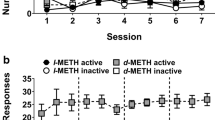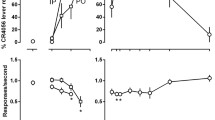Abstract
Rats were trained to discriminate between 0.25 mg/kg amphetamine (AMPH) and 0.03 mg/kg haloperidol (HAL) in a two-lever drug discrimination task. In order to test for a drug-induced withdrawal state, animals were assigned to one of three chronic treatment groups and given injections of AMPH, HAL, or distilled water (DW) for 10 consecutive days. Subjects from each treatment condition were then tested at 24, 48, or 72 h after the final injection. At the 24 h retest interval, subjects injected with AMPH responded as though administered an acute dose of HAL (0.028 mg/kg) and subjects injected with chronic HAL responded as though administered an acute dose of AMPH (0.15 mg/kg). By 72 h choice behavior had returned to pretreatment values. To determine whether the rebound observed after 10 days of drug treatment was present after a single injection, independent groups of subjects were injected with single doses of either 10 mg/kg AMPH or 1.0 mg/kg HAL and then retested from 4 h to 48 h later. Single doses of both AMPH and HAL produced significant rebounds that peaked between 20 h (AMPH) and 24 h (HAL) following administration. In a third experiment, animals were tested with or without acute doses of drug following pretreatment with either HAL or AMPH. Receptor supersensitivity accounts for the tolerance observed to HAL 24 h after treatment with 1.0 mg/kg HAL, whereas receptor subsensitivity accounts for the tolerance observed 20 h after treatment with 10 mg/kg AMPH.
Similar content being viewed by others
References
Barrett RJ (1985) Behavioral approaches to individual differences in substance abuse: drug-taking behavior. In: Galizio M, Maisto SA (eds) Determinants of substance abuse: biological psychological, and environmental factors. Plenum Press, New York, pp 125–175
Barrett RJ, Leith NJ (1981) Tolerance to the discriminative stimulus properties ofd-amphetamine. Neuropharmacology 20:251–255
Barrett RJ, Smith RL (1988) Time dependent pentylenetetrazol-like cues subsequent to diazepam administration. Psychopharmacology 96:169–173
Barrett RJ, Steranka LR (1983) Drug discrimination in rats: evidence for amphetamine-like cue state following chronic haloperidol. Pharmacol Biochem Behav 18:617
Caul WF, Burgin KL, Barrett RJ (1989). Drug-discrimination training during chronic treatment affects the development of tolerance. Behav Neurosci 103:373–377
Colpaert FC, Kuyps JJMD, Niemegeers CJE, Janssen PAJ (1976) Discriminative stimulus properties of fentanyl and morphine: tolerance and dependence. Pharmacol Biochem Behav 5:401–408
Colpaert FC, Niemegeers, CJE, Janssen PAJ (1978) Studies on the regulation of sensitivity to the narcotic cue. Neuropharmacology 17:705–713
Haenlein M, Caul WF, Barrett RJ (1985) Amphetamine-haloperidol discrimination: Effects of chronic drug treatment. Pharmacol Biochem Behav 23:949–952
Koob GF, Stinus L, Le Moal M, Bloom FE (1989) Opponent process theory of motivation: neurobiological evidence from studies of opiate dependence. Neurosci Biobehav Rev 13:135–140
McKenna ML, Ho BT (1977) Induced tolerance to the discriminative stimulus properties of cocaine. Pharmacol Biochem Behav 7:273–276
Michaelis RC, Holohean AM, Criado JR, Harland RD, Hunter GA, Holloway FA (1988) The chlordiazepoxide/pentylenetetrazol discrimination: characterization of drug interactions and homeostatic responses to drug challenges. Psychopharmacology 96:15–20
Sannerud CA, Young AM (1987) Environmental modification of tolerance to morphine discriminative stimulus properties in rats. Psychopharmacology 93:59–68
Shannon HE, Holtzman SG (1976) Evaluation of the discriminative effects of morphine in the rat. J Pharmacol Exp Ther 198:54–65
Author information
Authors and Affiliations
Rights and permissions
About this article
Cite this article
Barrett, R.J., White, D.K. & Caul, W.F. Tolerance, withdrawal, and supersensitivity to dopamine mediated cues in a drug-drug discrimination. Psychopharmacology 109, 63–67 (1992). https://doi.org/10.1007/BF02245481
Received:
Revised:
Issue Date:
DOI: https://doi.org/10.1007/BF02245481




